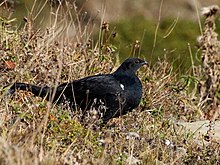The Caucasian grouseorCaucasian black grouse (Lyrurus mlokosiewiczi) is a large bird in the grouse family. It is closely related to the black grouse (L. tetrix).
| Caucasian grouse | |
|---|---|

| |
| Scientific classification | |
| Domain: | Eukaryota |
| Kingdom: | Animalia |
| Phylum: | Chordata |
| Class: | Aves |
| Order: | Galliformes |
| Family: | Phasianidae |
| Genus: | Lyrurus |
| Species: |
L. mlokosiewiczi
|
| Binomial name | |
| Lyrurus mlokosiewiczi (Taczanowski, 1875) | |
| Synonyms | |
|
Tetrao mlokosiewiczi | |

As with many gamebirds, the cock (male) is larger than the hen (female), measuring 50–55 cm compared to her length of 37–42 cm. The cock is very distinctive, with all-black plumage, apart from red eyebrows, and a long, deeply forked tail. The female Caucasian grouse is grey with dark barring, and has a cackling call.[2]
It occurs in extreme southeastern Europe and adjacent regions. The scientific name of this bird commemorates the Polish naturalist Ludwik Mlokosiewicz. The Caucasian grouse is a sedentary species, breeding in the Caucasus and Pontic Mountains of northeast Turkey and Iran on open slopes with low Rhododendron or other scrubs but in proximity to deciduous broad-leaf forest.
They have a group display or lek in May and June. Unlike the male Eurasian black grouse, the Caucasian grouse display is almost mute but for a thin whistling of the cock fluttering his wings as he leaps and turns in the air, producing a flash of white as the underwing feathers are briefly revealed.[2] The hen lays up to ten eggs in a ground scrape and takes all responsibility for nesting and caring for the chicks, as is typical with gamebirds.
It is perhaps the least-studied of all grouse in the world, and it was formerly classified as Data Deficient by the IUCN.[1][3] Recent research shows that it is declining to some extent, and it is consequently listed as a Near Threatened species in 2008[4] with an estimated population of 30,203–63,034 worldwide in 2010. Conservation efforts have included encouraging ecotourism as a way to promote awareness of the bird and its habitat.[5]